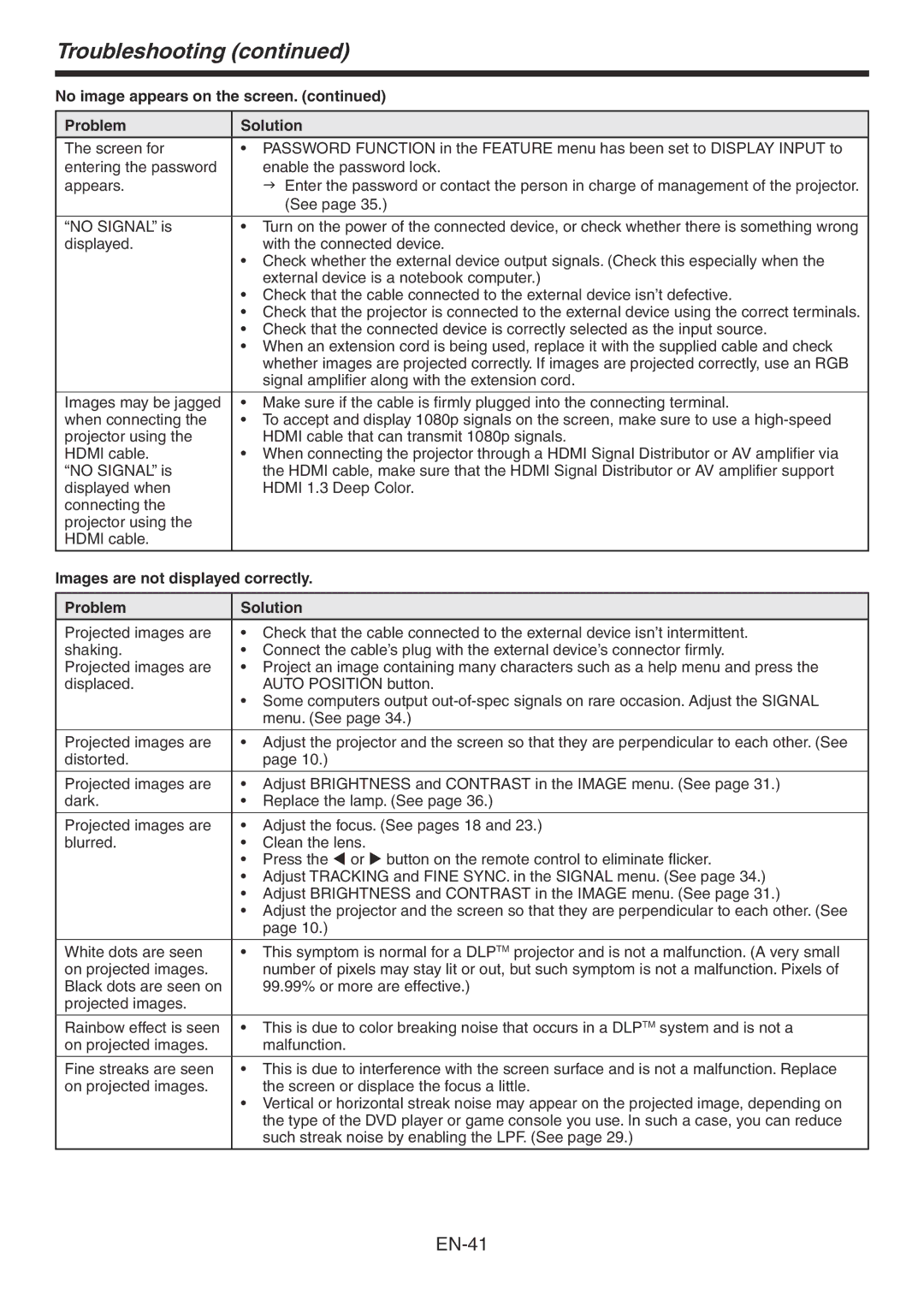
Troubleshooting (continued)
No image appears on the screen. (continued)
Problem | Solution |
|
|
The screen for | • PASSWORD FUNCTION in the FEATURE menu has been set to DISPLAY INPUT to |
entering the password | enable the password lock. |
appears. | Enter the password or contact the person in charge of management of the projector. |
| (See page 35.) |
|
|
“NO SIGNAL” is | • Turn on the power of the connected device, or check whether there is something wrong |
displayed. | with the connected device. |
| • Check whether the external device output signals. (Check this especially when the |
| external device is a notebook computer.) |
| • Check that the cable connected to the external device isn’t defective. |
| • Check that the projector is connected to the external device using the correct terminals. |
| • Check that the connected device is correctly selected as the input source. |
| • When an extension cord is being used, replace it with the supplied cable and check |
| whether images are projected correctly. If images are projected correctly, use an RGB |
| signal amplifier along with the extension cord. |
|
|
Images may be jagged | • Make sure if the cable is firmly plugged into the connecting terminal. |
when connecting the | • To accept and display 1080p signals on the screen, make sure to use a |
projector using the | HDMI cable that can transmit 1080p signals. |
HDMI cable. | • When connecting the projector through a HDMI Signal Distributor or AV amplifier via |
“NO SIGNAL” is | the HDMI cable, make sure that the HDMI Signal Distributor or AV amplifier support |
displayed when | HDMI 1.3 Deep Color. |
connecting the |
|
projector using the |
|
HDMI cable. |
|
|
|
Images are not displayed correctly. | |
|
|
Problem | Solution |
|
|
Projected images are | • Check that the cable connected to the external device isn’t intermittent. |
shaking. | • Connect the cable’s plug with the external device’s connector firmly. |
Projected images are | • Project an image containing many characters such as a help menu and press the |
displaced. | AUTO POSITION button. |
| • Some computers output |
| menu. (See page 34.) |
|
|
Projected images are | • Adjust the projector and the screen so that they are perpendicular to each other. (See |
distorted. | page 10.) |
|
|
Projected images are | • Adjust BRIGHTNESS and CONTRAST in the IMAGE menu. (See page 31.) |
dark. | • Replace the lamp. (See page 36.) |
|
|
Projected images are | • Adjust the focus. (See pages 18 and 23.) |
blurred. | • Clean the lens. |
| • Press the t or u button on the remote control to eliminate flicker. |
| • Adjust TRACKING and FINE SYNC. in the SIGNAL menu. (See page 34.) |
| • Adjust BRIGHTNESS and CONTRAST in the IMAGE menu. (See page 31.) |
| • Adjust the projector and the screen so that they are perpendicular to each other. (See |
| page 10.) |
|
|
White dots are seen | • This symptom is normal for a DLPTM projector and is not a malfunction. (A very small |
on projected images. | number of pixels may stay lit or out, but such symptom is not a malfunction. Pixels of |
Black dots are seen on | 99.99% or more are effective.) |
projected images. |
|
|
|
Rainbow effect is seen | • This is due to color breaking noise that occurs in a DLPTM system and is not a |
on projected images. | malfunction. |
|
|
Fine streaks are seen | • This is due to interference with the screen surface and is not a malfunction. Replace |
on projected images. | the screen or displace the focus a little. |
| • Vertical or horizontal streak noise may appear on the projected image, depending on |
| the type of the DVD player or game console you use. In such a case, you can reduce |
| such streak noise by enabling the LPF. (See page 29.) |
|
|
